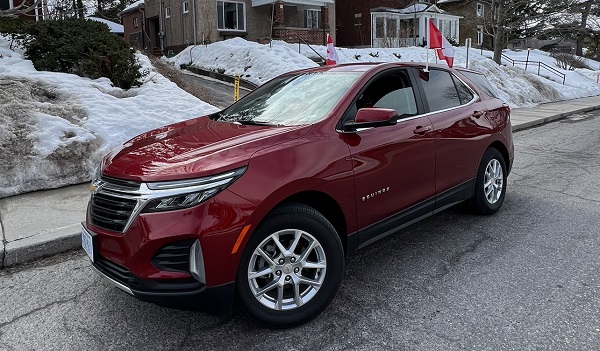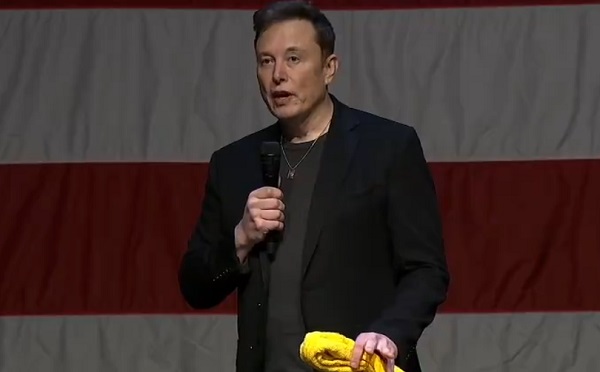Automotive
Trudeau’s new vehicle ban is a non starter

From the Canadian Taxpayers Federation
Author: Kris Sims
The Trudeau government’s ban on new gas and diesel vehicles is a nonstarter for three powerful reasons.
First, Canadians want to drive gas-powered minivans and diesel pickups.
Second, Canada does not have the electrical power to fuel these battery-powered cars.
Third, Canadians do not have the money to build the power-generating stations that would be needed to power these government-mandated vehicles.
Let’s start on the showroom floor.
The Trudeau government is banning the sale of new gasoline and diesel-powered vehicles by 2035.
In about 10 years’ time, Canadians will not be allowed to buy a new vehicle powered by an internal combustion engine because the government will forbid it.
Canadians disagree with this.
The Canadian Taxpayers Federation released Leger polling showing 59 per cent of Canadians oppose the federal government’s ban on new gas and diesel vehicles.
Among those who are decided on the issue, 67 per cent of Canadians, and majorities in every demographic, oppose the Trudeau government’s ban.
Now let’s look under the hood.
Canada does not have the electricity to charge these battery-powered cars. The government hasn’t presented any plan to pay for the power plants, transmission lines and charging stations for these government-mandated vehicles.
That leaves a big question: How much will this cost taxpayers?
Canada’s vehicle transition could cost up to $300 billion by 2040 to expand the electrical grid, according to a report for Natural Resources Canada.
Let’s look at why this will cost so much.
The average Canadian household uses about 10,861 kWh in electricity per year. The average electric car uses about 4,500 kWh of energy per year.
The average household’s electricity use would jump by about 40 per cent if they bought one EV and charged it at home.
Canada is home to 24 million cars and light trucks that run on gasoline and diesel, according to Statistics Canada.
If all those vehicles were powered by electricity and batteries, that fleet would use about 108 million mWh of power every year.
For context, one large CANDU nuclear reactor at the Darlington nuclear plant in Ontario generates about 7,750,000 mWh of power per year.
Canada would require about 14 of these reactors to power all of those electric cars.
Building a large nuclear reactor costs about $12.5 billion.
That’s a price tag of about $175 billion just for all the power plants. The Natural Resources report estimates the transition to electric vehicles could cost up to $300 billion in total, when new charging stations and power lines are included.
Who would be paying that tab? Normal Canadians through higher taxes and power bills.
Canadians cannot afford the cost of these mandatory electric vehicles because they’re broke.
Canadians are broke largely because of high taxes and high inflation, both driven by the Trudeau government’s wasteful spending.
About half of Canadians say they are within $200 of not being able to make the minimum payments on their bills each month. That’s also known as barely scraping by.
Food banks are facing record demand, with a sharp increase in working families needing help. That means parents who are holding down jobs are still depending on donated jars of peanut butter to feed their kids.
Rubbing salt into the wound, the federal government also put taxpayers on the hook for about $30 billion to multinational corporations like Honda, Volkswagen, Stellantis and Northvolt to build EV battery factories.
The roadside sobriety test is complete, and the Trudeau government is blowing a fail on this policy.
Canadians are opposed to the Trudeau government banning the sale of new gasoline and diesel-powered vehicles.
Canada does not have the electricity to charge these battery-powered cars.
Canadians don’t have the money to build the new power plants, transmission lines and charging stations these vehicles would demand.
It’s time to tow this ban on new gas and diesel vehicles to the scrapyard.
Franco Terrazzano is the Federal Director and Kris Sims is the Alberta Director of the Canadian Taxpayers Federation
Alberta
Premier Smith says Auto Insurance reforms may still result in a publicly owned system

Better, faster, more affordable auto insurance
Alberta’s government is introducing a new auto insurance system that will provide better and faster services to Albertans while reducing auto insurance premiums.
After hearing from more than 16,000 Albertans through an online survey about their priorities for auto insurance policies, Alberta’s government is introducing a new privately delivered, care-focused auto insurance system.
Right now, insurance in the province is not affordable or care focused. Despite high premiums, Albertans injured in collisions do not get the timely medical care and income support they need in a system that is complex to navigate. When fully implemented, Alberta’s new auto insurance system will deliver better and faster care for those involved in collisions, and Albertans will see cost savings up to $400 per year.
“Albertans have been clear they need an auto insurance system that provides better, faster care and is more affordable. When it’s implemented, our new privately delivered, care-centred insurance system will put the focus on Albertans’ recovery, providing more effective support and will deliver lower rates.”
“High auto insurance rates put strain on Albertans. By shifting to a system that offers improved benefits and support, we are providing better and faster care to Albertans, with lower costs.”
Albertans who suffer injuries due to a collision currently wait months for a simple claim to be resolved and can wait years for claims related to more serious and life-changing injuries to addressed. Additionally, the medical and financial benefits they receive often expire before they’re fully recovered.
Under the new system, Albertans who suffer catastrophic injuries will receive treatment and care for the rest of their lives. Those who sustain serious injuries will receive treatment until they are fully recovered. These changes mirror and build upon the Saskatchewan insurance model, where at-fault drivers can be sued for pain and suffering damages if they are convicted of a criminal offence, such as impaired driving or dangerous driving, or conviction of certain offenses under the Traffic Safety Act.
Work on this new auto insurance system will require legislation in the spring of 2025. In order to reconfigure auto insurance policies for 3.4 million Albertans, auto insurance companies need time to create and implement the new system. Alberta’s government expects the new system to be fully implemented by January 2027.
In the interim, starting in January 2025, the good driver rate cap will be adjusted to a 7.5% increase due to high legal costs, increasing vehicle damage repair costs and natural disaster costs. This protects good drivers from significant rate increases while ensuring that auto insurance providers remain financially viable in Alberta.
Albertans have been clear that they still want premiums to be based on risk. Bad drivers will continue to pay higher premiums than good drivers.
By providing significantly enhanced medical, rehabilitation and income support benefits, this system supports Albertans injured in collisions while reducing the impact of litigation costs on the amount that Albertans pay for their insurance.
“Keeping more money in Albertans’ pockets is one of the best ways to address the rising cost of living. This shift to a care-first automobile insurance system will do just that by helping lower premiums for people across the province.”
Quick facts
- Alberta’s government commissioned two auto insurance reports, which showed that legal fees and litigation costs tied to the province’s current system significantly increase premiums.
- A 2023 report by MNP shows
Automotive
Bad ideology makes Canada’s EV investment a bad idea


It doesn’t bode well for our country that our economic security rests on tariff exceptions to be negotiated by Liberal politicians who have spent the majority of Trump’s public life calling him a “threat to liberal democracy” and his supporters racists and fascists. Their hostility doesn’t lend itself to fruitful diplomacy. In any event, Trump’s EV rollback and aggressive tariffs will spell disaster for the Canadian EV sector.
What does Donald Trump’s resounding win in the recent U.S. election mean for Canada? Unfortunately, there doesn’t seem to have been much thought about the answer to this question in Ottawa, because the vast majority of our political and pundit class expected his opponent to be victorious. Suddenly they’re all having to process this unwelcome intrusion of reality into their narrow mental picture.
Well, what does it mean?
It is early days, and it will take some time to sift through the various policy commitments of the incoming Trump Administration to unpack the Canadian angle. But one thing we do know is that a Trump presidency will be no friend to the electric vehicle industry.
A Harris administration would have been. But, Trump spent much of his campaign slamming EV subsidies and mandates, pledging at the Republican National Convention in July that he will “end the electric vehicle mandate on day one.”
This line was so effective, especially in must-win Michigan, with its hundreds of thousands of autoworkers, that Kamala Harris was forced to assure everyone who listened that the U.S. has no EV mandate, and that she has no intention of introducing one.
Of course, this wasn’t strictly true.
First, the Biden Administration, of which Harris was a part, issued an Executive Order with the explicit goal of a “50% Electric Vehicle Sales Share” by 2030. The Biden-Harris Administration (to use their own formulation) instructed their Environmental Protection Agency (EPA) to introduce increasingly stringent tailpipe emission regulations on cars and light trucks with an eye towards pushing automakers to manufacture and sell more electric and hybrid vehicles.
Their EPA also issued a waiver which allows California to enact auto emissions regulations that are tougher than the federal government’s, which functions as a kind of back-door EV mandate nationally. After all, auto companies aren’t going to manufacture one set of vehicles for California, the most populous state, and another for the rest of the country.
And as for intentions, though the Harris camp consistently held that her prior policy positions shouldn’t be held against her, it’s hard to forget that as senator she’d co-sponsored the Zero-Emission Vehicles Act, which would have mandated that all new vehicles sold in the U.S. be “zero emission” by 2040. During her failed 2020 presidential campaign, Harris accelerated that proposed timeline, saying that the auto market should be all-electric by 2035.
In other words, she seemed pretty fond of the EV policies which Justin Trudeau and Steven Guilbeault have foisted upon Canada.
For Trump, all of these policies can be filed under “green new scam” climate policies, which stifle American resource development and endanger national prosperity. Now that he’s retaken the White House, it is expected that he will issue his own executive orders to the EPA, rescinding Biden’s tailpipe instructions and scrapping their waiver for California. And though he will be hindered somewhat by Congress, he’s likely to do everything in his power to roll back the EV subsidies contained in the (terribly named) Inflation Reduction Act and lobby for changes limiting which EVs qualify for tax credits, and how much.
All of this will be devastating for the EV industry, which is utterly reliant on the carrots and sticks of subsidies and mandates. And it’s particularly bad news for the Trudeau government (and Doug Ford’s government in Ontario), which have gone all-in on EVs, investing billions of taxpayer dollars to convince automakers to build their EVs and batteries here.
Remember that “vehicles are the second largest Canadian export by value, at $51 billion in 2023 of which 93% was exported to the U.S.,” according to the Canadian Vehicle Manufacturers Association, and “Auto is Ontario’s top export at 28.9% of all exports (2023).”
Canada’s EV subsidies were pitched as an “investment” in an evolving auto market, but that assumes that those pre-existing lines of trade will remain essentially unchanged. If American EV demand collapses, or significantly contracts without mandates or tax incentives, we’ll be up the river without a paddle.
And that will be true, even if the U.S. EV market proves more resilient than I expect it to. That is because of Trump’s commitment to “Making America Great Again” by boosting American manufacturing and the jobs it provides. He campaigned on a blanket tariff of 10 percent on all foreign imports, with no exceptions mentioned. This would have a massive impact on Canada, since the U.S. is our largest trading partner.
Though Justin Trudeau and Chrystia Freeland have been saying to everyone who will listen how excited they are to work with the Trump Administration again, and “Canada will be fine,” it doesn’t bode well for our country that our economic security rests on tariff exceptions to be negotiated by Liberal politicians who have spent the majority of Trump’s public life calling him a “threat to liberal democracy” and his supporters racists and fascists. Their hostility doesn’t lend itself to fruitful diplomacy.
In any event, Trump’s EV rollback and aggressive tariffs will spell disaster for the Canadian EV sector.
The optimism that existed under the Biden administration that Canada could significantly increase its export capacity to the USA is going down the drain. The hope that “Canada could reestablish its export sector as a key driver of growth by positioning itself as a leader in electric vehicle and battery manufacturing, along with other areas in cleantech,” in the words of an RBC report, is swiftly fading. It seems more likely now that Canada will be left holding the bag on a dying industry in which we’re invested heavily.
The Trudeau Liberals’ aggressive push, driven by ideology and not market forces, to force Electric Vehicles on everyone is already backfiring on the Canadian taxpayer. Pierre Poilievre must take note — EV mandates and subsidies are bad for our country, and as Trump has demonstrated, they’re not a winning policy. He should act accordingly.
-

 Brownstone Institute13 hours ago
Brownstone Institute13 hours agoThe Most Devastating Report So Far
-

 Economy1 day ago
Economy1 day agoCOP 29 leaders demand over a $1 trillion a year in climate reparations from ‘wealthy’ nations. They don’t deserve a nickel.
-

 Censorship Industrial Complex17 hours ago
Censorship Industrial Complex17 hours agoAnother Mass Grave?
-

 Alberta16 hours ago
Alberta16 hours agoMAiD In Alberta: Province surveying Albertans about assisted suicide policies
-

 Alberta23 hours ago
Alberta23 hours agoOn gender, Alberta is following the science
-

 Energy1 day ago
Energy1 day agoOttawa’s proposed emission cap lacks any solid scientific or economic rationale
-

 International1 hour ago
International1 hour agoElon Musk praises families on X: ‘We should teach fear of childlessness,’ not pregnancy
-

 Bruce Dowbiggin12 hours ago
Bruce Dowbiggin12 hours agoCHL Vs NCAA: Finally Some Sanity For Hockey Families



